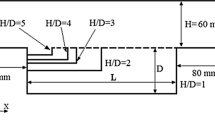Abstract
A “swallowtail” cavity for the supersonic combustor was proposed to serve as an efficient flame holder for scramjets by enhancing the mass exchange between the cavity and the main flow. A numerical study on the “swallowtail” cavity was conducted by solving the three-dimensional Reynolds-averaged Navier–Stokes equations implemented with a k–ε turbulence model in a multi-block mesh. Turbulence model and numerical algorithms were validated first, and then test cases were calculated to investigate into the mechanism of cavity flows. Numerical results demonstrated that the certain mass in the supersonic main flow was sucked into the cavity and moved spirally toward the combustor walls. After that, the flow went out of the cavity at its lateral end, and finally was efficiently mixed with the main flow. The comparison between the “swallowtail” cavity and the conventional one showed that the mass exchanged between the cavity and the main flow was enhanced by the lateral flow that was induced due to the pressure gradient inside the cavity and was driven by the three-dimensional vortex ring generated from the “swallowtail” cavity structure.
Similar content being viewed by others
References
Curran D.T., Heiser W.H., Pratt D.T.: Fluid phenomena in scramjet combustion systems. Ann. Rm. Fluid. Mech. 28, 323–360 (1996)
Kraus, D.K., Cutler, A.D.: Mixing enhancement by use of swirling jets. AIAA Paper 93-3126 (1993)
Gouskov, O., Kopchenov, V., Vinogradov, V., Waltrup, P.J.: Numerical researches of gaseous fuel pre-injection in hypersonic 3-D inlet. AIAA Paper 2000-3599 (2000)
Ben-Yakar, A., Hanson, R.K.: Cavity flame-holders for ignition and flame stabilization in scramjets: an overview. J. Propulsion Power 17(4) (2001)
Donohue, J.M., McDaniel, J.C. Jr., Haj-Hariri, H.: Experimental and numerical study of swept ramp injection into a supersonic flowfield. AIAA Paper 93-2445 (1993)
Eklund, D.R., Gruber, M.R.: Study of a supersonic combustor employing and aerodynamic ramp pilot injector. AIAA Paper 99-2249 (1999)
Wei M.J., Sun D.J., Yin X.Y. et al.: Stability analysis on supersonictrailing-line vortex. Acta Mech. Sin. 31(6), 694–699 (1999) (in Chinese)
Karamcheti, K.: Sound radiation from surface cutouts in high speed flow. Ph.D. Thesis, California Institute of Technology (1956)
Torda, T.P., Patel, B.R.: Analytical and experimental investigations of oscillations in rocket motor baffle cavities. NASA Tech Report, AD0849511
Davis, D.L.: Numerical analysis of two and three dimensional recessed flame holders for scramjet applications. Ph.D. Thesis, ADA324246
Huang, S.H., Xu, S.L., Liu, X.Y.: Numerical investigation on two phase flow of a kerosene-fueled scramjet with 3D cavity (I) Numerical calibration and characteristics of general flow. J. Propulsion Technol. 25(6) (2004) (in Chinese)
Hu Z.M., Lü J.M., Jiang Z.L. et al.: Numerical study on the performance of nozzle flow for supersonic chemical oxygen–iodine lasers. Acta Mech. Sin. 24(2), 133–142 (2008)
Chen J.Q., Zhuang F.G.: Numerical simulation of supersonic reacting mixing layer. Acta Mech. Sin. 13(2), 97–105 (1997)
Du T., Wu Z.N.: Mixed analytical/numerical method for low-Reynolds-number k–ε turbulence models. AIAA J. 42(6), 1140–1153 (2004)
Zhang H.X.: Non-oscillatory and non-free-parameter dissipation difference scheme. Acta Aerodyn. Sin. 5(2), 143 (1988) (in Chinese)
Wang C., Lu H.P., Ming S.T.: Numerical predictions of cold flowfield of supersonic combustor in dual-combustor ramjet. J. Propulsion Technol. 20(5), 35–38 (1999) (in Chinese)
Author information
Authors and Affiliations
Corresponding author
Additional information
The project was supported by the National Natural Science Foundation of China (10602059, 10632090).
Rights and permissions
About this article
Cite this article
Wang, C., Jiang, Z., Hu, Z. et al. Numerical investigation on the flowfield of “swallowtail” cavity for supersonic mixing enhancement. Acta Mech Sin 25, 37–44 (2009). https://doi.org/10.1007/s10409-008-0218-2
Received:
Revised:
Accepted:
Published:
Issue Date:
DOI: https://doi.org/10.1007/s10409-008-0218-2




